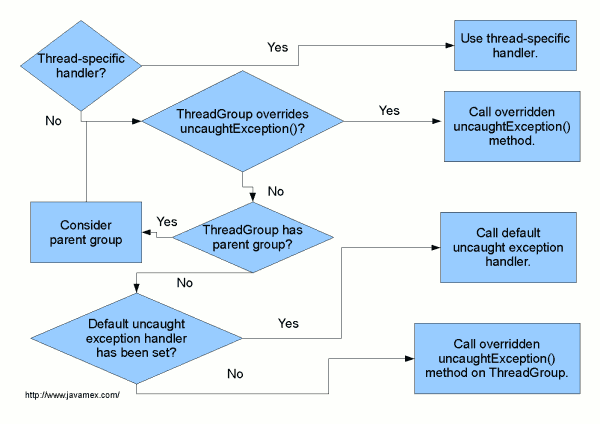

JVM 如何处理未捕获异常
source link: https://droidyue.com/blog/2019/01/06/how-java-handle-uncaught-exceptions/?amp%3Butm_medium=referral
Go to the source link to view the article. You can view the picture content, updated content and better typesetting reading experience. If the link is broken, please click the button below to view the snapshot at that time.
继之前的文章详解JVM如何处理异常,今天再次发布一篇比较关联的文章,如题目可知,今天聊一聊在JVM中线程遇到未捕获异常的问题,其中涉及到线程如何处理未捕获异常和一些内容介绍。
什么是未捕获异常
未捕获异常指的是我们在方法体中没有使用try-catch捕获的异常,比如下面的例子
private static void testUncaughtException(String arg) {
try {
System.out.println(1 / arg.length());
} catch (ArithmeticException e) {
e.printStackTrace();
}
}
上面的代码很有可能发生如下情况
- 如果方法参数arg传递null,会出现NullPointerException
- 如果参数arg传递内容为空的字符串(“”),会出现ArithmeticException
对于上面的问题,我们不难发现
- 上面可能出现的NullPointerException和ArithmeticException都属于Unchecked Exceptions
- 而ArithmeticException被我们人为try-catch捕获了,它不符合本文对于未捕获异常的定义
- NullPointerException 由于我们没有catch住,就变成了我们要聊的未捕获异常
- 另外,未捕获异常实际是Unchecked Exceptions的子集
UncaughtExceptionHandler 是什么
void uncaughtException(Thread t, Throwable e); Thread.setUncaughtExceptionHandler Thread.setDefaultUncaughtExceptionHandler
ThreadGroup 是什么
- ThreadGroup 是线程的集合
- ThreadGroup 也可以包含子ThreadGroup
- 除了初始的ThreadGroup 之外,每个ThreadGroup都有一个父 ThreadGroup
- ThreadGroup 自身实现了Thread.UncaughtExceptionHandler,用来相应处理其内部的线程和ThreadGroup发生未捕获异常。
未捕获异常处理者 设置指南

线程发生了未捕获异常,JVM怎么处理
分发Throwable实例
当线程A中出现了未捕获异常时,JVM会调用线程A的 dispatchUncaughtException(Throwable)
方法
/**
* Dispatch an uncaught exception to the handler. This method is
* intended to be called only by the JVM.
*/
private void dispatchUncaughtException(Throwable e) {
getUncaughtExceptionHandler().uncaughtException(this, e);
}
获取未捕获异常处理者
- 每个线程会有一个变量(uncaughtExceptionHandler)来保存未捕获异常的处理者
- 在线程需要确定Throwable分发目标的处理者时,优先获取当前线程中uncaughtExceptionHandler变量
- 如果出问题线程的uncaughtExceptionHandler为null(即没有显式设置异常处理者),则使用自己所在的ThreadGroup来作为未捕获异常处理者。
/**
* Returns the handler invoked when this thread abruptly terminates
* due to an uncaught exception. If this thread has not had an
* uncaught exception handler explicitly set then this thread's
* <tt>ThreadGroup</tt> object is returned, unless this thread
* has terminated, in which case <tt>null</tt> is returned.
* @since 1.5
* @return the uncaught exception handler for this thread
*/
public UncaughtExceptionHandler getUncaughtExceptionHandler() {
return uncaughtExceptionHandler != null ?
uncaughtExceptionHandler : group;
}
如果Throwable分发给ThreadGroup
Thread.getDefaultUncaughtExceptionHandler()
/**
* Called by the Java Virtual Machine when a thread in this
* thread group stops because of an uncaught exception, and the thread
* does not have a specific {@link Thread.UncaughtExceptionHandler}
* installed.
* <p>
* The <code>uncaughtException</code> method of
* <code>ThreadGroup</code> does the following:
* <ul>
* <li>If this thread group has a parent thread group, the
* <code>uncaughtException</code> method of that parent is called
* with the same two arguments.
* <li>Otherwise, this method checks to see if there is a
* {@linkplain Thread#getDefaultUncaughtExceptionHandler default
* uncaught exception handler} installed, and if so, its
* <code>uncaughtException</code> method is called with the same
* two arguments.
* <li>Otherwise, this method determines if the <code>Throwable</code>
* argument is an instance of {@link ThreadDeath}. If so, nothing
* special is done. Otherwise, a message containing the
* thread's name, as returned from the thread's {@link
* Thread#getName getName} method, and a stack backtrace,
* using the <code>Throwable</code>'s {@link
* Throwable#printStackTrace printStackTrace} method, is
* printed to the {@linkplain System#err standard error stream}.
* </ul>
* <p>
* Applications can override this method in subclasses of
* <code>ThreadGroup</code> to provide alternative handling of
* uncaught exceptions.
*
* @param t the thread that is about to exit.
* @param e the uncaught exception.
* @since JDK1.0
*/
public void uncaughtException(Thread t, Throwable e) {
if (parent != null) {
parent.uncaughtException(t, e);
} else {
Thread.UncaughtExceptionHandler ueh =
Thread.getDefaultUncaughtExceptionHandler();
if (ueh != null) {
ueh.uncaughtException(t, e);
} else if (!(e instanceof ThreadDeath)) {
System.err.print("Exception in thread \""
+ t.getName() + "\" ");
e.printStackTrace(System.err);
}
}
}
将上面的处理流程做成图的形式,就是下图所示

注:上述图片来自 https://www.javamex.com/tutorials/exceptions/exceptions_uncaught_handler.shtml
Questions
初始的ThreadGroup是什么
上面提到了初始的ThreadGroup没有父ThreadGroup,是主线程所在的ThreadGroup么?
这个问题,我们可以通过这样一段代码验证
private static void dumpThreadGroups() {
ThreadGroup threadGroup = Thread.currentThread().getThreadGroup();
while(threadGroup != null) {
System.out.println("dumpThreadGroups threadGroup=" + threadGroup.getName());
threadGroup = threadGroup.getParent();
}
}
执行该方法对应的输出是
dumpThreadGroups threadGroup=main dumpThreadGroups threadGroup=system
因此我们可以发现,初始的ThreadGroup是一个叫做system的ThreadGroup,而不是main ThreadGroup
setDefaultUncaughtExceptionHandler 设置的一定会被调用到么
这其实是一个很好的问题,答案是不一定会被调用,因为可能存在以下的情况
- 出问题的线程设置了对应的UncaughtExcpetionHandler,优先响应分发到这个Handler
- 出问题的线程所在的ThreadGroup包括其祖先ThreadGroup 重写了uncaughtException 也可能造成线程默认的Handler无法被调用
- 出问题的线程重写了dispatchUncaughtException 可能性较小
- 出问题的线程重写了getUncaughtExceptionHandler 可能性较小
参考声明
Recommend
About Joyk
Aggregate valuable and interesting links.
Joyk means Joy of geeK